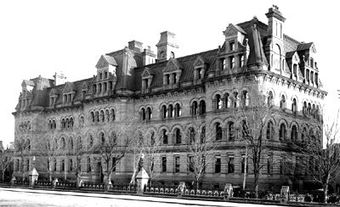Safety Standards
Safety Standards, documents or codes which describe characteristics or usage for products, materials and services, are intended to protect citizens from the hazards of technology. A safety standard may specify how to test a hockey helmet for resistance to blows, or how to design an electric coffee pot that does not present the danger of electrocution. Several thousand standards are currently in use in Canada.
Standards are published by sector and government organizations specializing in this field and are grouped in the National Standards System, co-ordinated by the Standards Council of Canada. The work of standardization begins when public hazards are recognized and involves field and laboratory studies. Standards are written up by experts, who volunteer their time to standards-writing organizations. Standards prepared, published and revised in this fashion are known as consensus standards; their final acceptance depends on substantial agreement among the experts.
Unless made obligatory by law, standards are applied voluntarily by those concerned. Laws making standards mandatory often refer to specific consensus safety standards, rather than specifying detailed technical requirements. Safety standards relating to a specific subject may be collected into volumes, called codes, which are usually drawn up in a way that would allow governments to adopt them for legal use.
Several codes have gained wide recognition in Canada, notably the National Fire Code, the National Building Code, the Canadian Electrical Code, the Boiler Code, the Canadian Welding Code and the Code for Hospital Operating Room Safety. The National Labour Code also includes safety legislation.
The National Fire Code sets out the requirements for safe maintenance of buildings after their occupation. Drawing heavily on American and, to a lesser extent, on Canadian standards, this code establishes standards for fire prevention, fire fighting and life safety in buildings in use.
The National Building Code is essentially a set of minimum regulations for the safety of buildings with reference to public health, fire protection and structural sufficiency (see BUILDING CODES AND REGULATIONS). Complementing the National Fire Code, it establishes standards for fire safety during construction of new buildings or reconstruction of old ones. The code also sets out specifications for the use, occupancy and design of buildings.
Provincial and territorial governments exercise jurisdiction over fire and construction safety in Canada and each has adopted, wholly or in part, the 2 national codes.
Electricity posed great danger of electrocution when it first came into public use. Over the years a collection of Canadian electrical safety standards has been assembled into what is now known as the Canadian Electrical Code, a completely Canadian product acclaimed in many parts of the world.
Published by the Canadian Standards Association (CSA), the code is consulted by engineers and inspectors responsible for electrical installation in all buildings and engineering structures. Each province requires that all electrical appliances sold within it comply with the code's specifications and bear a mark certifying this compliance.
One of the earliest matters to receive attention in the field of safety standards was the control of boilers and other pressure vessels. When they were first used in steam engines for the propulsion of boats early in the 19th century, pressure vessels often exploded.
Today the Boiler Code, published by the Canadian Standards Association, promotes the safe use of such vessels. Relying heavily on the American Boiler Code (first issued in 1914), it presents information for the design of pressure vessels and requirements for their construction, testing and regular inspection.
Establishment of standards in the medical field is fairly recent. With new developments in medicine the medical and engineering professions began to work closely together to develop standards, eg, for metallic surgical implants. In co-operation with representatives of industry and medicine, CSA published a Code for Prevention of Explosions or Electric Shock in Hospital Operating Rooms. This code, which specifies safety features in operating theatres (especially safety from danger of explosions caused by anaesthetics), is widely used across Canada.
Certain requirements in the medical field are of international interest. For example, steel bottles containing compressed gases needed by hospitals must be safe and readily connectable to other hospital equipment; the screw couplings on these containers are a matter of lively international study. The federal government, through the Health Protection Branch of HEALTH CANADA, plays an active role legislating standards in the medical field. It regulates medical devices (eg, cardiac pacemakers, contraceptive devices). A product cannot be sold until it is approved by the federal government.
Safety standards often bear an international flavour, as in the transportation field. Many standards used in Canada originated in other countries or with international organizations, eg, the International Organization for Standardization and the International Electrotechnical Commission, in both of which the Standards Council of Canada is actively involved.
Most international marine safety standards are developed by the Inter-Governmental Maritime Consultative Organization of the United Nations. Canada is represented on this organization by marine and fire research experts. Documents resulting from this work are used as guidelines by the federal government, which legislates all aspects of international transportation.
The International Civil Aviation Organization, with headquarters in Montréal, performs similar functions in the field of aviation. Nationally, transportation is administered by the federal government, with some areas delegated to provinces and territories. The Motor Vehicle Safety Act, Motor Vehicle Tire Safety Act, National Transportation Act, Railway Act, Canada Shipping Act and Aeronautics Act govern most federal transportation issues. The Acts are exhaustive and specify everything from requirements for automobile windshields and mirrors to aircraft speed limits.

 Share on Facebook
Share on Facebook Share on X
Share on X Share by Email
Share by Email Share on Google Classroom
Share on Google Classroom

